|
July 29
We fell into a regular routine
that we followed every day (except on moving days when we traveled
to a new camp). Each morning KP or Open would give us our wake-up
call at six, and bring warm water for our washbasins.
Once up and dressed, we would stand around the fire having
our tea or coffee, and a breakfast of hot porridge and toast was
served at 6:30. Gee would take us out on the morning game drive at
seven. We would stop for a tea break around ten. We would usually
return to camp sometime around 1:00, to find Open waiting to greet
us with a tray holding goblets of ice tea, often with sugar-coated
rims.
At 1:30 lunch would be served,
always with a fresh salad and a hearty main course, and with
separate entrees for Rosemary and Nick, the vegetarians. After
lunch we would have showers and relax a while. If we had left
laundry out in the morning, it would be waiting for us in the
afternoon, cleaned and folded. Our beds were always beautifully
made, and the towels often folded into animal shapes. We felt very
much pampered.
|
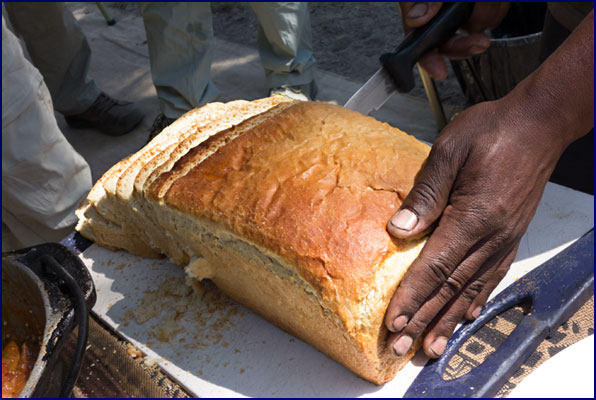
Fresh bread baked in camp!
|
Afternoon
tea and cake was served at three, and Gee would take us back out
for the afternoon drive at 3:30. We would return to camp around
6:30, and sit around the campfire having wine or gin-and-tonics
until Mosa shyly announced dinner about eight o’clock. The food,
cooked over the fire or in Dutch ovens, was always amazing -
complete with appetizers, salads, homemade breads, vegetables,
main courses and dessert – with separate starters and entrees
for the vegetarians. We would serve ourselves buffet style - the
vegetarians were always invited to go first, followed by the
ladies and then the men. Afterwards
we would go back to the fire and sit talking with Gee until we
were too tired to keep our eyes open – usually around ten
o'clock. Crawling into bed, the hot water bottles under the covers
made the day complete.
Heading
out on this morning, we started with birds. As usual there were
plenty of guinea fowl, francolins and hornbills. We saw several
beautiful sand grouse, and Sally identified a crimson-breasted
shrike. I continued with my photographic attempts to capture a
lilac-breasted roller in flight. A kori bustard hid in the bushes;
these handsome birds tend to be well-camouflaged despite their
large size.
|

Kori Bustard
|
We
were able to get quite close to a family of giraffes with a fairly
small baby. We watched as they browsed in the trees, nimble lips
picking the leaves from among the thorns. A big bull giraffe
cantered across in front of us, appearing to move in slow motion
with huge ground-covering strides. (A giraffe’s normal canter
gait is what would be called a cross-canter in a horse.)
A
small herd of zebras grazed on the plain, several babies among
them. I never tire of watching these charming equids. Their stripe
patterns are varied and unique, each one different, like
fingerprints. Their bold stripes are said to confuse and dazzle
predators close up, but from a distance they appear grey and fade
into the landscape.
We
watched one poor zebra that had several oxpeckers really going to
town on him, practically crawling into his ear looking for ticks.
The zebra would shake his head angrily and the birds would fly up,
startled, only to be back burrowing for parasites a few seconds
later. (Obviously they should really be called zebra-peckers.) Gee
told us that if the oxpeckers can’t find ticks or parasites,
they will pick at scabs and raw wounds on their host
animals.
We watched the antics of a herd of
wildebeest as they ran back and forth across the plain. One big
male seemed to be pursuing another; Gee said he was trying to
chase away a competitor. He wouldn’t give it up - he continued
chasing his rival until he had the whole heard running in circles.
Nick called it a gnu
kerfuffle. They were kicking up a great cloud of dust; perhaps
this is what caused the greyish haze we had noticed around
the horizon.
|
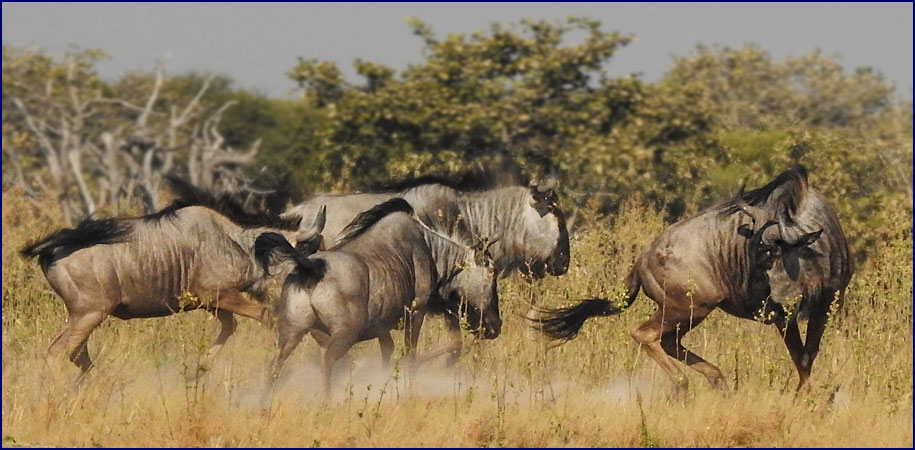
Wildebeest in action |
Zebras,
giraffes and wildebeests were all mingled together - but there was
one lone giraffe with an injured knee slowly making his way across
the plain; we thought that sadly he would be lion bait soon, as he
could not run or defend himself. The circle of life in the African
bush is not gentle.
We
came across a huge herd of buffalo, easily over two hundred
strong. We watched them file past on their way to the river. The
biggest bulls were massive, weighing up to a ton. Their coats were
scruffy and caked with mud, and they squinted at us nearsighted,
snorting malevolently. A number of the females had half-grown
calves by their sides. The buffalos’ ears seemed to be split
into three sections; at first I thought they had been torn and
tattered, but Gee told us they were born that way, to mimic the
leaves when they hide among the trees. He pointed out that several
of the buffalo had yellow-billed oxpeckers on them, relatively
rare compared to the red-billed ones we had been seeing.
We
looked back as we drove down a narrow track and saw wild dogs in
action. Half a dozen of them crossed the roadway behind us – one
of them was carrying a large bone in his mouth as he ran. The Official
Photographer vehicle
we had seen the previous day was close on their tails. I was a
little envious - I would have loved to go watch the dogs hunt!
|
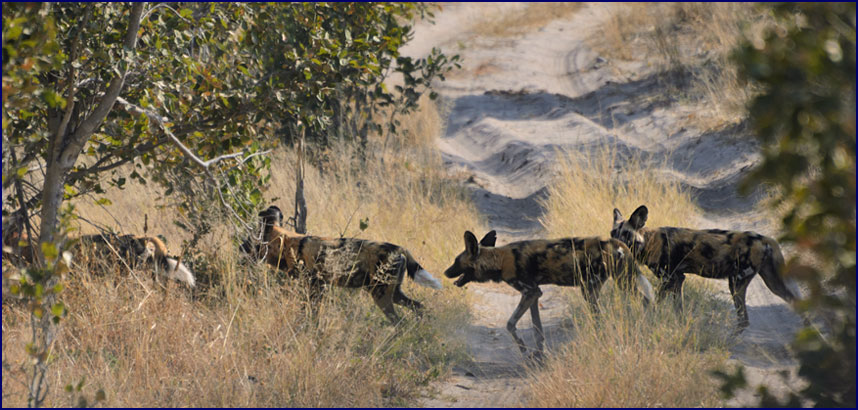
African Wild Dogs |
We
forded the Savuti River, and then stopped for a tea break in a
beautiful open meadow right beside the water. A fish eagle stood
sentinel in a treetop, looking for all the world like a bald eagle
with its bold white head and neck. We took turns going over a
small ridge for nature’s call - once Gee had checked it out to
be sure there were no predators lurking. A pied kingfisher hovered
like a giant hummingbird over the river, periodically diving for
fish. I amused myself trying to photograph such moving targets as
a fluttering butterfly and a flying banana peel thrown in the air
by Jineen.
Moving on, we saw six tiny dwarf
mongooses poking their heads out from a termite hill. A little
bee-eater sat on a twig, brilliant green in the sunshine. We
passed warthogs by the road, and a big herd of impala. A
lilac-breasted roller sitting on a twig in the sunlight displayed
most of the colors of the rainbow. Several female kudus went
running across the road in front of us in leaps and bounds,
seemingly on a mission.
|
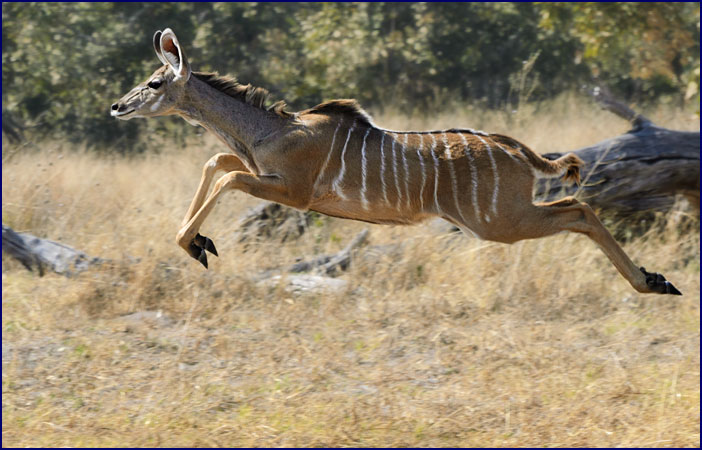
Kudu
|
Gee
saw a flash of color and stopped; searching with the binoculars he
and Sally identified a scarlet-chested sunbird deep in a bush.
These iridescent little birds have a long curved beak for sipping
nectar, and look a bit like a hummingbird, though larger. They are
beautiful but quick, so it is difficult to get a good look at
them.
Driving along the narrow dirt
track, Gee suddenly spotted the head and neck of a male ostrich a
ways from the road; we couldn’t see the rest of him because he
was lying down. ‘No,’ Gee said when asked the inevitable
question, ‘they do NOT bury their heads in the sand.’
He seemed amazed at the idea. ‘How would they breathe?’
He did tell us that they would lie down to be less visible though.
We
saw a vulture flying overhead, and it soon became evident what was
attracting him. Beside a big rocky ridge was our same pride of
nine lions, feasting on a recently killed buffalo, probably one of
the same ones we had seen heading for the river earlier.
Four
or five of the lions were lined up at the carcass side by side,
tearing at the flesh savagely, occasionally snarling at each other
and quarreling over the grisly remains. They were liberally
smeared with blood and gore, and flies buzzed all around. Several
of the lions buried their heads in the carcass, burrowing in to
the body cavity in search of the tastiest bits, while others
climbed over the top of the body. As they pulled at the dead
buffalo its head would move or a leg would suddenly poke in the
air, for an instant giving the illusion that he was still alive.
It was hard to watch, and yet some primal part of me found it
oddly thrilling - I was revolted but yet oddly transfixed.
|
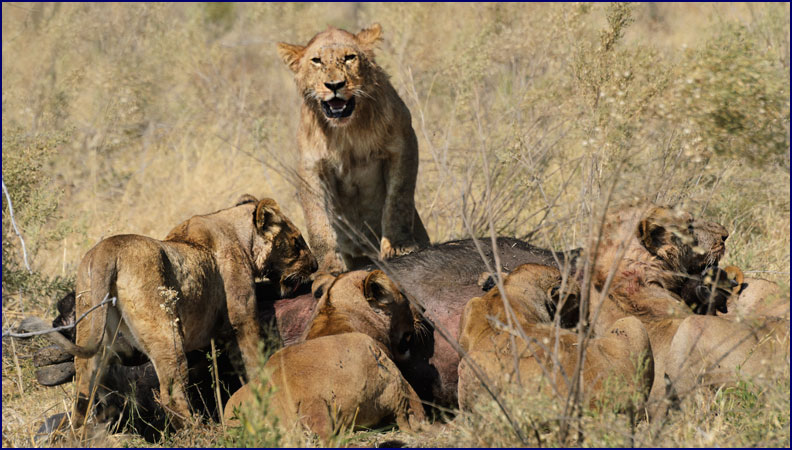
The Buffalo Buffet |
It
was the young lions that were feeding; the older lionesses were
sleeping nearby, bellies full and apparently sated. There was
still no sign of the pride’s dominant male; Gee said he must
have been off patrolling his territory and didn’t know about the
kill. Wouldn’t the lionesses call him to dinner, I asked? I knew
the sound of their roars would carry for miles. But Gee said no;
the male might call out, but the females won’t answer. A male
lion feeds first and won’t let the others eat until he is done,
and sometimes there is not enough left - so the lionesses try to
keep the kill secret until the youngsters have eaten their fill.
Contrary to popular belief male lions can and do hunt, but it is
usually the females that feed the cubs.
After
a while we left the lions and headed back toward camp, none too
soon for Rosemary. Mary said now that we had seen lions eating a
buffalo, all we needed was a leopard with a kill – it never
hurts to ask! We saw our ostrich again, now running through the
trees, flaunting his black and white plumage. A kori bustard paced
through the underbrush.
Gee
spotted a flash of movement; we just barely caught a glimpse of
something leaping through the brush, and then a puff of dust. Gee
followed the roadway around to the other side of the thicket to
get closer, and there was a leopard with a slender mongoose
hanging from his mouth. The leopard was young and quite thin; Gee
said he needed to kill something larger than that little mongoose
to get enough to eat - but at least he had lunch.
We
were impressed with Gee’s conjuring skills. Mary had a theory
that all you had to do was say your wishes out loud and it would
happen. She had told Gee she wanted to see a leopard with a kill,
and sure enough he found one within minutes. I put in a request
for a giraffe drinking. Nick asked for a bushbaby. George said he
would like to get a photo of a hippo, rising up out of the water
open-mouthed, with the setting sun between his jaws like a ball.
When
we went back out for the afternoon drive we soon came upon more
wildebeest. These ungainly-looking creatures are sometimes called
the spare parts animal,
said to be made from the parts left over after God made all the
other animals.
We crossed a flat sparse plain and came
to a watering hole, where we found two elephants standing in the
shallow water having a drink. We could see their reflections in
the water. They were taking their time over it; perhaps it was
their equivalent of having a drink at a bar after work.
We
had only been there a minute when a very tall giraffe came to join
them. He walked right past our land cruiser and stood in front of
the water. He was not concerned about our presence or the
elephants’, but scanned the bushes looking for predators. His
dappled coat was an unusually dark color, and he was magnificent.
The afternoon light was perfect for photography, and we watched
him for a long while.
The
giraffe stood and looked around for quite some time before
nervously splaying out his long front legs and lowering his head
to the water. After a few sips he raised his head again to warily
scan the area for danger, then crouched back down to drink. Gee
explained that while their heads are down to the water is when
giraffes are most vulnerable to attacks from lions. A giraffe
drinking; another item off our wish list had been fulfilled
already!
It
may be anthropomorphizing, but to me the giraffes appear to be
serene and wise. They have a tranquil eye and long amazing
eyelashes. This one watched us benevolently, oxpeckers clinging to
his neck, and then walked off in a stately manner. Another giraffe
approached, considered having a drink, but decided against it and
left.
The
two elephants took a mud bath, using their trunks to throw wet mud
over themselves to cool off. Then they waded deeper into the pool
for a drink, sucking up great quantities of water in their trunks
and squirting it into their mouths. When they were finished
drinking they stood tranquilly in the water, just taking it easy.
One of them stood with his trunk hooked casually over one tusk. A
blacksmith plover waded along the near edge of the water.
Gee
got a radio report that there was some action over at the buffalo
carcass. The dominant male lion, presumably out patrolling his
territory from interlopers, had not been with the pride earlier -
perhaps he had returned?
Amazingly, the nine lions were
still feeding when we arrived. How much can they eat? Several were
sleeping, their bellies bloated. Others lounged nearby lazily,
yawning and stretching. The exertion of eating so much seemed to
have worn them out! Those lined up at the carcass looked somewhat
lethargic as well. A couple of the teenagers were trying to fit
their whole head, neck and shoulders into the buffalo’s chest
cavity. There was no sign of the big male.
But
a mile further on, we did find the male lion, walking regally
across the plain. He was huge, with a thick dark reddish-brown
mane. Gee told us that he was about 8 to 10 years old. The lion
didn’t know where his pride was and he looked hungry - I felt a
little sorry for him. Surely the ladies would let him know where
the kill was now that the kids had eaten?
Once
again Gee parked in just the right spot, and lion walked straight
toward us. As he approached Gee quietly reminded us to be quiet
and still, and in all his majesty the lion walked within feet of
where we were sitting, almost within touching distance. As he
passed he looked me in the eye, and a shiver ran up my spine. He
had amber eyes that seemed to look into your soul, displaying
wisdom and perhaps a touch of cruelty.
We
watched the lion stroll across the bushveld under a dusky pink
sky. He walked with imperious confidence; clearly he knew he was
the King of the Beasts. Gee repositioned the land cruiser to get
ahead of him, and again the lion walked right to us. He stopped
and sniffed the ground and bared his teeth. Then he turned and
looked back over his shoulder toward the sunset with a wistful
look in his eyes. In that moment I thought he was the most
magnificent creature I had ever seen.
As
we returned to camp the sky was painted in brilliant shades of
orange, red and rose. We watched the nearly-full moon rise as we
sat by the fire. This was to be our final night in Savuti. The
tent over the dining table had already been taken down in
preparation for moving camp, as had our bucket showers. We dined
under the stars.
Sitting around the campfire, Gee
described his childhood growing up with his family on an island in
the Okavango Delta. He told us about how he had gotten started
guiding; he had always loved wildlife, and when he learned he
could make a living as a guide he knew that was the life for him.
We asked him about the most
frightening wildlife encounter he had ever experienced, and Gee
told us about the time that he was charged by an angry elephant.
Having no other options, he sat down on the ground in front of it,
hoping to make himself less of a threat. Apparently it worked,
since he survived! He told us that the elephant stopped right in
front of him and kicked dirt on him, and he remained immobile
until it went away. One can only imagine the nerve it would take
to sit down in front of a charging elephant!
Gee recounted several scary
encounters he’d had with lions as a youth. He also gave us a
number of examples of how dangerous elephants can be. He told us
it is not unusual for people to be killed by elephants in Africa -
usually on walking safaris. I thought back on our experience in
Hwange when we walked up to the bull elephant; perhaps in Zimbabwe
they have a much higher risk tolerance for such things than in
Botswana.
When
we told Gee about our Hwange adventure, he commented that you
could never tell when an elephant would be in a bad mood and
decide to crush you. I had really enjoyed the encounter at the
time, but now I had second thoughts. I believe Botswana’s more
careful policies are probably wiser. (Later,
hearing of Quinn’s untimely death from the lion at Hwange, I
felt this was confirmed.)
We heard hyenas calling in the
night, just outside our tent – they were so close we could hear
them walking. And in the wee morning hours we heard lions calling
in the distance - had the big male found his family yet?
|